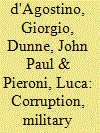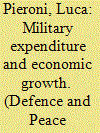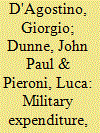|
|
|
Sort Order |
|
|
|
Items / Page
|
|
|
|
|
|
|
| Srl | Item |
| 1 |
ID:
116064


|
|
|
|
|
| Publication |
2012.
|
| Summary/Abstract |
This paper considers the effect of corruption and military spending on economic growth, analysing both the direct impact of public spending and the effect of allocating resources between categories of public spending within the framework of an endogenous growth model. The model exhibits non-linearities as a result of the links between the components of public spending, corruption and economic growth. The main findings of the empirical analysis confirm the expectation that corruption and military burden lower the growth rate of gross domestic product per capita. They also suggest that when the effect of the complementarity between military spending and corruption is omitted, as in most studies, the impact of military burden on economic performance is underestimated.
|
|
|
|
|
|
|
|
|
|
|
|
|
|
|
|
| 2 |
ID:
153086


|
|
|
|
|
| Summary/Abstract |
The effects of military spending has on the economy continues to be a subject of considerable debate, with a lack of consensus in the literature. This paper takes advantage of the Stockholm International Peace Research Institute extended data-set to contribute to the debate using empirical methods made available, or more applicable, by the extra observations. It constructs a large panel of countries for the period 1970–2014 to explore the long-run equilibrium relationship between military spending and economic growth, applies the more flexible pooled mean group estimator, and compares the results with the more restrictive dynamic fixed effect method used in earlier influential studies. It also compares results from different time and country samples. Across the specifications it finds a significant and persistent negative effect of military burden on economic growth that is robust across different country groups, with the largest impact being for OECD countries.
|
|
|
|
|
|
|
|
|
|
|
|
|
|
|
|
| 3 |
ID:
090392


|
|
|
|
|
| Publication |
2009.
|
| Summary/Abstract |
This paper tests the relationship between military expenditure and economic growth by including the impact of the share of military and civilian components of government expenditure in an economic growth model with endogenous technology. In this framework, we empirically consider the hypothesis of a non-linear effect of military expenditure on economic growth. Differences between the costs and benefits of the defence sector has traditionally explained the non-linear relationship suggesting that shocks to insecurity may also be a source of non-linearity as they determine a re-allocative effect within government expenditure. While parametric partial correlations are in line with empirical findings, the robustness of estimations is tested by using a non-parametric approach. The negative relationship between military expenditure and growth in countries with high levels of military burden predicted by theory becomes significant only after including a proxy for re-allocative effects in the growth equation.
|
|
|
|
|
|
|
|
|
|
|
|
|
|
|
|
| 4 |
ID:
167859


|
|
|
|
|
| Summary/Abstract |
While not always a concern for the general economic growth literature, the debate over the effects of military spending on growth continues to develop, with no consensus, but a deepening understanding of the limitations of previous work. One important issue that has not been adequately dealt with is the endogeneity of military spending in the growth equation, mainly because of the difficulty of finding any variables that would make adequate instruments. This paper considers this issue, using an endogenous growth model estimated on a large sample of 109 non-high-income countries for the period 1998–2012. The empirical analysis is framed within an instrumental variable setting that exploits the increase in military spending that occurs when unrest in a country escalates to turmoil. The estimation results show that endogeneity arising from reverse causality is a crucial issue, with the instrumental variable estimates providing a larger significant negative effect of military spending on growth than OLS would. This result is found to be robust to different sources of heterogeneity and different time periods.
|
|
|
|
|
|
|
|
|
|
|
|
|
|
|
|
| 5 |
ID:
172144


|
|
|
|
|
| Summary/Abstract |
This paper contributes to the analysis of the impact of military spending and corruption on economic growth, by considering not only the political dimension of corruption, distorting the allocation of resources to sectors, but also the impact on the efficiency of the bureaucratic environment. It does this by developing the model of Mauro (2004) in the context of an endogenous growth model to deal with corruption in the defence sector. It then uses data from the International Country Risk Guide to produce a novel measure of corruption that combines corruption within the political system, institutional strength, quality of bureaucracy and the degree of military participation in the country and estimates the model for a large panel of countries. The results suggest that both military spending (as a share of total government spending) and corruption have significant negative long run effects on output. As the model also suggests that multiple equilibria can exist, a comparison is made between high and low corruption groups of countries and clear differences are indeed found. This suggests that effort is needed to encourage and coerce high corruption and military spending countries, but low corruption and military spending countries are likely to need little attention.
|
|
|
|
|
|
|
|
|
|
|
|
|
|
|
|
|
|
|
|
|